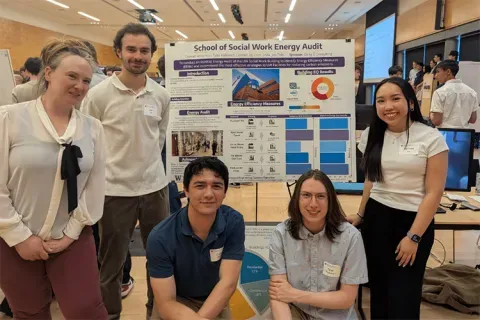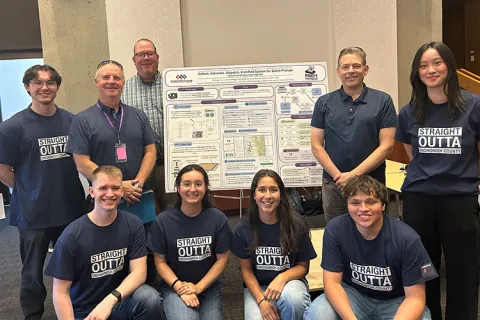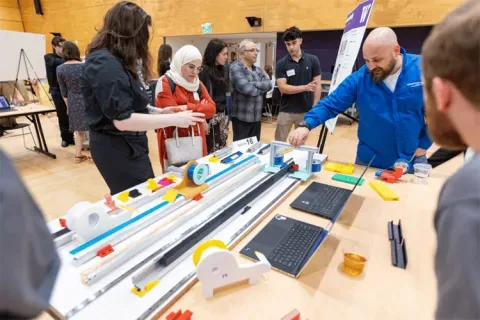Industry-Sponsored Student Capstone Projects
2022/2023
In the 2022/23 academic year the industry capstone program was supported by 56 sponsors and 99 real-world projects. Nearly five hundred and fifty students from across the College of Engineering participated. Scroll down to learn more about each project.
PACCAR
Battery Electric Vehicle (BEV) Range Estimation Tool
With multiple new battery electric powertrains under development, there is a need to optimize component sizing and select the right configuration for different real-world vehicle applications. The goal of this project was to include the different components of a BEV powertrain and a generic optimization algorithm to determine required component sizing such as batteries, e-motors, etc. In prior years, an algorithm was determined to help estimate energy consumption based off a drive cycle. This year, the student team worked to design a user interface tool that would help determine the best component sizing for an application and is capable of optimizing the vehicle configuration based on user inputs and variables (i.e., battery sizing for a given drive cycle, vehicle weight and mass, and motor size). This tool was intended to evaluate and optimize powertrain configuration based on a different drive cycles and performance requirements. The student team was expected to prioritize GUI over adding complexity to the model. The model could have been updated from the previous project, or be used as-is, depending on time available and the skill set/interests of the group. Due to the large number of variables, optimization algorithms / machine learning were required to reduce computational costs.

PACCAR
Develop a Model for Completing Vehicle System Life Cycle Assessments
This student team worked to develop a tool that can be used to determine the environmental impact of a vehicle system in the five stages of life cycle assessment: raw materials, manufacturing, distribution, in-use, recycling/end-of-life. At the time of this project, PACCAR was working on improving the sustainability of its products and needs a tool to identify and measure the environmental impact of vehicle systems to improvements. The transportation industry was under increasing pressure from regulations, investors, and customers to reduce its environmental impact, this student team worked to aid in identifying opportunities to reduce the environmental impact of the transportation industry and to establish performance criteria for consideration in future part design and procurement. An anticipated outcome this student team worked to accomplish is a functional conceptual model for LCA of a vehicle system that can be used for any vehicle system and allow for direct comparison between systems.

PACCAR
Driver Classification
This student team worked to add a new classification layer and behavioral prediction to autonomous driving. The main objective was to classify and predict reckless drivers by identifying specific trends and indicators while continuously monitoring the vehicle's surrounding area. Due to the complexity of the objective, the project scope was divided into multiple phases, with Phase I taking place in the 2022/23 Industry Capstone Program. PHASE I: This phase was meant as a proof of concept. The algorithms the student team worked to create in this phase are intended to be tested on a small-scale database. A small-scale database contains a limited number of training data and testing objects, which was to be defined in detail during the early stages of the project. The Phase I student team was expected to: - identify the specific indicators for reckless driving - generate a prediction algorithm based on the identified indicators - detect and classify a specific vehicle - track and monitor the behavior of the classified vehicle. Phase I and 2 student teams worked to classify and identify driving characteristics that represent reckless behavior, including creating requirements that would identify reckless behavior. For these phases and subsequent phases, a stretch goal was for the student team(s) to identify additional driving characteristics/targeted behavioral patterns, such as: “dead pedal”, speeder, weaver, angry/aggressive, brake checker, vehicle speed limited, strict speed limit follower, normal, erratic, inattentive, defensive, etc., and define written requirements for these additional driving characteristics/targeted behavioral patterns.

PACCAR
LFP Battery Recycling Analysis
PACCAR is currently evaluating LFP batteries and needs a life cycle assessment completed to evaluate possible use at the end of life and environmental impact of manufacturing and in-use stages. This student team worked to develop a decision tree analysis for 1) assessment of LFP battery usability for second life and 2) to determine how to maximize the use of the battery materials depending on their state at the end-of-vehicle life. This student team also worked to estimate the cost of battery component disposal compared to the value of a battery in a secondary use with respect to the charge state at the end-of-vehicle life. A desired outcome for this project was for the student team to work to create an analysis report to evaluate the end-of-vehicle life stage through end-of-life stage, or second use through recycling or disposal.

PACCAR
State of Health Analysis for LFP Battery Second Life
BEV batteries still have some usable life once they are at vehicle end of life. These electric batteries see battery degradation typically due to exposure to high temperature, rapid charge and discharge cycles, and repeated utilization of maximum storage potential of the battery over time. This student team sought to understand the battery degradation over time along with the historical performance behavior of the battery, as this would help PACCAR to understand the battery second life repurposes. This student team attempted to analyze battery State of Health (SOH) through the vehicle life cycle and propose its future for its 2nd life once the batteries are at end of life for the vehicle use. The outcome this student team worked towards was an analysis report to complete a SOH analysis on the battery at the end-of-vehicle life stage through end-of-life stage.

PACCAR
Validated Material Model with Damage
Paccar Technical Center currently does not have validated material model with damage. With limited requirements for crash/impact analysis in truck industry and a focus more towards durability analysis, there was no urgent need for material model validation with damage associated with it. However, with Paccar's development on the Battery electric vehicle and the requirement associated with impact analysis, the need for validated material model with failure has become utmost importance in order to provide good prediction on impact scenarios. This student team worked to create a test set-up for casting material (maybe one of PACCAR's casting components) with failure (coupon testing) to gather all the relevant data for material model development. This student team also worked to develop the material model with damage created, verified, and validated by test data.

PATH
Harvest and Prioritize Excess Solar Power
PATH, with partners, has previously worked to specify and field test "energy harvesting" equipment for solar powered vaccine refrigerator installations that have been approved by the World Health Organizations Performance, Quality, and Safety team. The critical refrigeration load always receives the power it needs while any additional power can be accessed by additional user loads. PATH has a long history of product development of technologies that are fit for difficult situations and addressing unmet user needs and opportunities. Oxfam currently provides technical support to the humanitarian water, sanitation, and hygiene (WASH) sector for quality implementation of solar powered water pumping solutions. The power system (solar photovoltaic array) is sized to account for cloudy days and periods of low insolation which means there is excess power available most of the time. Oxfam is often asked if there is a way to tap this unused power at water pump installations, but no commercial technology exists for this application. PATH has been approached by Oxfam to work toward a parallel energy harvesting product for these installations. This student team worked to take initial steps toward defining and designing a technology to harvest this extra power for other uses while ensuring that the primary water pumping system still receives all the power it needs. More broadly, this development ideally would lead towards design of a universal device that could be used in any similar solar powered systems that generate unused power. Desired outcomes this student team worked towards included: 1. Initial landscape of similar technologies, preliminary confirmation that there aren't already products out there that just need modification (this has been done, but a more comprehensive landscape and research will be useful at the outset). 2. A basic target product profile (TPP) document to solidify design requirements and targets 3. Conceptual design following the TPP with a design review 4. Conceptual design of the physical user interface for power/load prioritization (possibly with basic, opportunistic user feedback) 5. Initial prototyping of an example device 6. Documentation of design in form of white paper or defensive publication

PATH
Mobile Emergency Care System
Approximately 2.7 million people are bitten by venomous snakes annually, leading to 138,000 deaths globally. Victims are generally poor subsistence farmers in rural communities of low- and middle-income countries (LMICs), and for every death there are 3-5 victims who survive but are permanently disfigured or disabled. Given that snakebite envenomings occur predominately in rural areas and the window for care is limited, it becomes incumbent upon the victim to travel to the nearest care facility as fast as possible. In these environments, though, the travel time to a care facility is often measured in hours. This tyranny of distance also holds true for other life-threatening conditions that the world's rural poor face. In rare instances a few communities have developed ambulance or ambulance-like networks, but resource constraints often mean that these are little more than just vehicles to transport patients, with no ability to stabilize or deliver care en-route. This student team worked to design a mobile emergency care system should incorporate the minimum required devices for ground ambulances found in high-resource settings. This was able to include but was not limited to a laryngeal mask-airway system/ventilator, suction circuit, syringe driver/infusion pump, and suite of vital sign monitoring tools (pulse oximeter, thermometer, sphygmomanometer or equivalents). Potential broader scope could have included an AED. It was aimed to support both adult and pediatric use. Conversations with clinicians/EMS personnel helped inform a target product profile.

PATH
The Impact of Respiratory Care Equipment Product Proliferation on Spare Parts Supply Chains
To treat severely ill COVID-19 patients, medical oxygen is critical. Oxygen requires a set of different biomedical devices to be produced, stored and administered as well as devices to monitor a patient's response to treatment. Program for Appropriate Technology in Heath (PATH) collected data on medical devices in various low and middle income countries and found that public health facilities own a brought variance of device makes and models - even within a facility. Some device categories have upwards 25 different makes and models. This large variability has severe operational consequences. One consequence is spare parts proliferation: for many different makes and models different spare parts are required. Spare parts proliferation increases cost and introduces complexity into the supply chain. This student team worked to create a quantitative model capturing the important dynamics and explore the consequences of proliferation. Outcomes this student team worked towards included a quantitative analysis showing the impact of equipment proliferation on spare parts supply chains in low-and-middle income countries and a qualitative description of managerial approaches to reduce the negative consequences.

Philips
Quantification of the Usage/Life Counter for Cables/Paddles
There are many detachable cables used by EMS and hospitals for patient care. These cables are reusable and so can be used frequently or rarely depending on the situation. Two examples are ECG leads and internal/external defibrillation paddles. Hospitals and EMS systems do not currently have a good way of tracking the age and wear on cables and companies cannot easily set warranty coverage. This project aimed to develop creative methods to track the reuse and reprocessing cycles (cleaning) without relying on user interaction (logs, etc.).
Photon Marine
Marine Range Estimation Calculator for EV Systems
Photon Marine is developing electric outboard propulsion systems and intelligent energy management software for commercial boat fleets. These fleets operate in tourism, transportation, and mariculture sectors, traversing the most fragile marine ecosystems in the world. One of the primary considerations for transitioning to electric propulsion is whether or not the batteries will provide sufficient range for a particular use case. Because each case is unique, blending a combination of vessel type, distance traversed, operating speed, charging infrastructure available, and ambient weather conditions, the answer to "how far can I go?" depends on a number of factors. This student team worked to to build a real-time range estimation tool, as part of Photon Marine's onboard software platform, in order to understand how useful ICE motor data can be in modeling for electric systems. The system this student team worked to build could incorporate environmental data from wind and tide sensors, understand where the vessel departed from and needed to return to, and keep a long of boat performance over time. This would allow the system to learn from previous trips to create accurate range estimation. This student team also worked to develop an early functioning prototype for range calculation. As a stretch goal, this student team worked to produce a design or a prototype for a public-facing website tool so that prospective customers can pre-qualify whether electric propulsion suits them. Such a tool might also gather a few more data points such as cost of electricity and fuel costs in order to determine payback period for an electric propulsion system.
Puget Sound Energy (PSE)
Transmission System Hosting Capacity Map
Puget Sound Energy (PSE) faces an increasing need to acquire generation resources to meet customer demand, as well as the renewable resource goals outlined in the Clean Energy Transformation Act. Developers seeking to interconnect generation to the system, as well as load (including charging of Battery Energy Storage Systems), face increased congestion due to factors such as electrification, EV adoption and an increased penetration of DER. This system congestion results in increased interconnection costs for the developer, who bear the costs of the system upgrades needed to accommodate these resources. This student team worked to develop a transmission system hosting capacity map to indicate to developers which areas of the system may be constrained and where there may be available capacity to accommodate new resources. This map may also be used to identify areas where PSE can target proactive projects to facilitate the integration of renewable resources. The hosting capacity needed to be determined for both generation and load in consideration of system performance requirements under NERC credible contingencies. The desired project outcome for this student team was a methodology and (potentially automated) process for calculating hosting capacity on all PSE transmission lines. This student team worked to complete calculation of hosting for both generation and load under a variety of NERC credible contingencies (including all lines in service, N-1 and N-1-1) for both summer and winter seasons for the upcoming year. As time allowed, this student team was able to work to study and represent additional scenarios on the map (such as studying an 10-year scenario to identify whether future system projects will benefit/impact hosting capacity) . This student team worked to deliver a GIS map that color codes transmission facilities based on the amount of capacity available for interconnecting new resources.
Puget Sound Restoration Fund (PSRF)
Seaweed Solutions: Harnessing Wind and Sun for Drying Nuisance Seaweed
Intertidal shellfish operations in Puget Sound can be burdened by seaweed that accumulates on cultivation gear throughout the growing season, oftentimes suffocating clams, oysters and other farmed shellfish. These seaweeds grow quickly and abundantly during warm months, fueled by nutrients from upland sources, the ocean, and nutrients excreted by the shellfish themselves. While seaweeds absorb carbon and nitrogen and initially provide food and habitat for marine organisms, they also decompose, releasing the nutrients back into the environment. This can then contribute to the degradation of local water quality and threaten the livelihoods of many shellfish growers in Puget Sound. PSRF, in partnership with three shellfish growing operations, is leading a two-year pilot project to develop experimental removal systems and market pathways for the excess seaweed that accumulates on and in aquaculture gear at the participating shellfish farms. Wet seaweed is heavy and immediately begins to decompose once removed from the salt water, so an important part of the project the students worked towards is extending the “shelf life” of seaweed and enabling its use in burgeoning seaweed-based markets. Some growers have established relationships with local organic farmers that can most often receive the seaweed as soon as it is harvested, while others aim to stockpile a biomass for new markets. Transport, however, of wet seaweed is incredibly labor intensive and time sensitive. This student team worked to look for ways and/or systems to eliminate the time sensitivity and labor associated with transporting wet seaweed by reducing the weight (and moisture content) and jump-starting the oxygenation process of the seaweed on site to reduce noxious/unpleasant odors. This student team also worked to develop a passive drying system in order to produce a lightweight, easily transported seaweed biomass product. While solving a here-and-now problem for growers, this student team also worked to help recycle seaweed into sustainable pathways and be integral to the potential for renewing sea-to-land nutrient flows in response to actions identified by the Blue Ribbon Panel to help mitigate Ocean Acidification, (a product of climate change) in Puget Sound. Desired outcomes of this project included this student team working to deliver a schematic drawing of the full proposed system and working to develop a physical prototype of the proposed system (full or partial).
RadiusAI
Photo-Realistic Synthetic Image Generation
Radius AI is on the forefront of AI-driven retail and healthcare computer vision-driven systems. As part of our retail expansion at the time of this project, Radius AI was categorizing an ever-expanding list of consumer products. For this project, this student team set out to investigate, research, and develop state-of-the art methods for photo-realistic synthetic image generation. This student team also worked to propose solutions ranging from AI/GAN based approaches to 3D reconstruction, implement object detection and recognition, and demonstrate any resulting improvements. Desired outcomes and deliverables this student team worked towards included creating a proven methodology that may be used to scale-ably create diverse training scenes. This student team worked to: a) Deliver a report or presentation discussing all methodologies that were attempted b) Deliver the resulting codebase in the form of a github that may be utilized by RadiusAI
Sagetech Avionics
Bluetooth Converter Module with Integrated GPS
Sagetech Avionics designs micro transponders and collision avoidance systems for use in primarily UAS but are also relevant to crewed aircraft. Their products provide data out via RS232 using a custom protocol. In order to interface with applications that will display their data, this student team worked to design equipment that will convert the display data to GDL-90 protocol and send it via bluetooth to a IOS and Android application. Sagetech provided most of the hardware design that students will work to tweak and send out to Fab. Most of the work was to be software. This student team worked to develop the following application features: Powered by 5V Converts 232 ADS-B in report data to GDL-90 to be displayed on Foreflight Custom Sagetech Application to program Sagetech devices IOS and Android Applications Provides GPS data out Anticipated outcomes of this project included: FPS - Functional Product Spec SRS - System Requirement Spec Requirements Trace matrix that allocates high level (SRS) requirements to specific low level functions (HW, SW, Mechanical) Low level requirements docs Test plans to cover all requirements documents Prototype hardware that can be used on multiple UAS to be tracked on a common display application on a smart phone/tablet.
Related News

Mon, 10/13/2025 | UW Mechanical Engineering
Capstone collaboration leads to award
An ME capstone team received first place for its energy audit of the UW School of Social Work building.

Thu, 07/17/2025
UW engineering students develop smart ballot solution
UW engineering students develop smart technology solution to improve ballot collection for Snohomish County.

Mon, 07/07/2025 | UW Mechanical Engineering
Capstone creations
Students displayed innovative capstone design projects at the 2025 expo.

Fri, 09/20/2024 | UW Civil & Environmental Engineering
Smarter irrigation for a greener UW
A new project combines satellite data with ground sensors to conserve water and create a more sustainable campus environment.